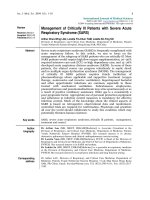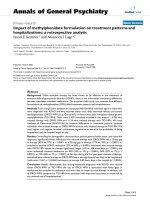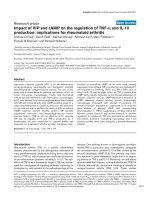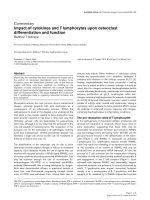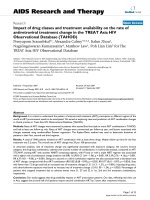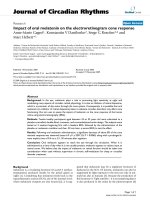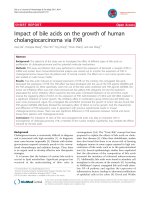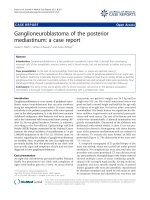Báo cáo y học: " Impact of delayed admission to intensive care units on mortality of critically ill patients: a cohort study" pot
Bạn đang xem bản rút gọn của tài liệu. Xem và tải ngay bản đầy đủ của tài liệu tại đây (374.18 KB, 8 trang )
RESEARCH Open Access
Impact of delayed admission to intensive care
units on mortality of critically ill patients: a cohort
study
Lucienne TQ Cardoso, Cintia MC Grion
*
, Tiemi Matsuo, Elza HT Anami, Ivanil AM Kauss, Ludmila Seko,
Ana M Bonametti
Abstract
Introduction: When the number of patients who require intensive care is greater than the number of beds
available, intensive care unit (ICU) entry flow is obstructed. This phenomenon has been associated with higher
mortality rates in patients that are not admitted despite their need, and in patients that are admitted but are
waiting for a bed. The purpose of this stud y is to evaluate if a delay in ICU admission affects mortality for critically
ill patients.
Methods: A prospective cohort of adult patients admitted to the ICU of our institution between January and
December 2005 were analyzed. Patients for whom a bed was available were immediately admitted; when no bed
was available, patients waited for ICU admission. ICU admission was classified as either delayed or immediate.
Confounding variables examined were: age, sex, originating hospital ward, ICU diagnosis, co-morbidity, Acute
Physiology and Chronic Health Evaluation (APACHE) II score, therapeutic intervention, and Sequential Organ Failure
Assessment (SOFA) score. All patients were followed until hospital discharge.
Results: A total of 401 patients were evaluated; 125 (31.2%) patients were immediately admitted and 276 (68.8%)
patients had delayed admission. There was a significant increase in ICU mortality rates with a delay in ICU
admission (P = 0.002). The fraction of mortality risk attributable to ICU delay was 30% (95% confidence interval (CI):
11.2% to 44.8%). Each hour of waiting was independently associated with a 1.5% increased risk of ICU death
(hazard ratio (HR): 1.015; 95% CI 1.006 to 1.023; P = 0.001).
Conclusions: There is a significant association between time to admission and survival rates. Early admission to the
ICU is more likely to produce positive outcomes.
Introduction
When the number of patients requiring intensive care
management is greater than the number of beds avail-
able, ICU entry flow i s obstructed [1] and the critically
ill patient has to be cared for in hospital wards with
non-specialized staff. Critically ill patients need early
interventions to improve outcomes [2-7]; therefore, the
phenomenon of waiting for ICU bed availability has
been suggested to be associated with higher mortality
[8-12]. The positive impact of ICU admission on patient
survival is more evident during the first 72 hours of
critical illness [13]. In the face of an aging and increas-
ingly morbid global population [14], timely access to
ICU beds becomes increasingly important [15,16].
The waiting time for ICU bed availability varies
between hospitals and countries, and typically ranges
from 2 hours to 3.5 days [8-12,17-19]. The proportion
of patients who wait for ICU admission varies from 2.1
to 75.5% [8-12,20-22], depending on how delays are cal-
culated. Some studies show no clear association between
delayed admission and poor outcome [11,23]. Other stu-
dies report a five times higher risk of death, and a two
times longer stay among patients not immediately
admitted to the ICU [10].
* Correspondence:
Hospital Universitário de Londrina, Divisão de Terapia Intensiva, Avenida
Robert Koch 60, Vila Operária, Londrina, Paraná 86038-450, Brazil
Cardoso et al. Critical Care 2011, 15:R28
/>© 2011 Cardoso et al.; licensee BioMed Central Ltd. This is an open access article distributed under the terms of the Creative C ommons
Attribu tion License (h ttp://creativecommons.org/licenses/by/2.0), which permits unrestr icted use, distribution, and reproduction in
any medium, provided the original work is properly cite d.
It has been shown that patients meeting ICU admis-
sion criteria and treated in the ICU, compared to those
treated out of the ICU, had a survival benefit [13].
There are few reports about delay in ICU admission due
to obstruction of entry flow, especially in Latin Ameri-
can ICUs. Indeed, this public health care issue is becom-
ing more prevalent in both developed [9,11,18,21] and
developing countries [8,12].
The challenge of this study was to provide outcome
data about critically ill patients who were initially trea-
ted in regular wards before an ICU bed became avail-
able. The aim of this study is to compare mortality rates
of patients immediately admitted to the ICU with those
who were required to wait for ICU bed availability.
Materials and met hods
This study was approved by the Londrina University
Hospital Ethics Committee, whic h waived the require-
ment for informed consent.
Setting and study design
We present a prospective cohort study of patients
admitted to our 17-bed general adult ICU. The ICU
staff consisted of certified intensivists who remained
constant throughout the study. All patients were
referred from our hospital; patients from other hospita ls
were not included.
Inclusion and exclusion criteria
All patients consecutively admitted to the ICU from Jan-
uary to December 2005 were prospectively considered
for inclusion in the study. Inclusion criteria for ICU
admission were adopted from SCCM guidelines [24].
Exclusion criteria were: age less than 18 years of age;
readm ission to the ICU during the same hospitalization;
patients who were transferred to other hospitals, who
were considered to be lost to follow-up; electi ve surgery
with prior assured access to the ICU (this group of
patients has a lower risk of death [25] and would be
allocated in the immediately admitted group, biasing
interpretation of data); patients with less than 24 hours
between ICU admission and discharge (death or less
acuity); delay to admission longer than 72 hours, exceed-
ing the suggested critical window of benefit [13,26].
Data collection and definitions
Patients were immediately admitted if there was an ICU
bed available. If not, the screening intensivist registered
the request in an ICU access protocol and treatment
was provided by the ward staff; ICU consultation in
these cases was routinely part of the treatment. After
ICU admission, patients were t reated according to ICU
protocols and all interventions were pros pectively
documented.
The need to wait for ICU admission due to bed una-
vailability was con sidered an exposure, and defined as
the “delayed admission group”. Those who were imme-
diately admitted, or non-exposed, were defined as the
“immediate admission group”.Dateandhourofthe
determination of ICU requirement were recorded, as
well as that of ICU admission.
Patients who were required to wait for an ICU bed
were admitted in chronological order, or on a “first
come, first served” basis. This criterion was adopted
based on the recommendations of the American T hor-
acic Society Bioethics Task Force. This recommendation
specifically states that when the need for ICU beds
exceeds available resources, patients should be admitted
by arrival order [27]. Rearrangement of this order was
allowed due to administrative or medical orders. For the
immediate admission group waiting time was considered
zero. The following demographic data were collected:
sex, age, previous hospital length of stay, length of ICU
stay, Acute Physiology and Chronic Health Evaluation
(APACHE) II score and comorbidities [25], need for
mechanical ventilation and tracheal intubation, vasoac-
tive drug use, Therapeutic Intervention Scoring System
(TISS) 28 score [28] on the first (TISS 28 D1) and last
day of ICU, Sequential Organ Failure Assessment
(SOFA) score [29] on the first d ay of ICU (SOFA D1).
The hospital ward was stratified in two main categories:
the emergency ward, composed of adult hospital beds
for short hospital stays in the emergency department
and general hospital wards.
The delayed admission group had two calculated
APACHE II scores: the first score refers to the first
24 hours after ICU orders, and the second score used
data collected during the first 24 hours after ICU admis-
sion. Follow-up continued until ICU, hospital discharge,
and mortality rate was registered.
To independently evaluat e age and comorbidities in
multivariate analysis, the APACHE II score was disso-
ciated with age, comorbidity, and Acute Physiology
Score (APS) [30]. This approach was applied to the
score calculated at the time of ICU ordering and at ICU
admission.
Delay to ICU admission was also considered a contin-
uous predictive v ariable in the Cox model of propor-
tional risks. The primary outcome examined was ICU
mortality. Other outcomes examined were hospital mor-
tality, duration of mechanical ventilation, and length of
stay in the ICU and hospital.
Statistical analysis
Calculations of variables for cohort studies were per-
formed with the Epitable program, (EpiInfo, version
6.04b, CDC, Atla nta, Georgia, USA) [31]. A to tal of 239
patients was calcula ted to detect a 20% reduction of
Cardoso et al. Critical Care 2011, 15:R28
/>Page 2 of 8
absolute risk [11] with 95% confidence interval, 80%
power, and a 1:2 non-exposure/exposure ratio.
Patient characteristics in the delayed and immediate
admission groups were compared using non-paired
t tests for continuous variables with normal distribution,
the Mann-Whitney test for variables with non-Gaussian
distribution, and t he Wilcoxon rank sum test for paired
samples of ICU ordering and admission scores in the
delayed admission group. A normal distribution of vari-
ables was evaluated by the D’Agostino-Pearson test.
Pearson’s chi-square test was applied to categorical vari-
ables. The chi-square trend test was applied to analyze
ICU mortality rate, accor ding to delay categories.
Association strength between delayed admission and
mortality was described by relative risk. Impact of this
association was described as attributable risk, according
to the following formula: AR% = ((RR - 1)/RR) × 100
[31]. Multivariate Cox regr ession model was applied to
evaluate delay to ICU admission and mortality consider-
ing confounding factors. A stepwise forward method
was applied by entering relevant variables sequentially
and after checking them, removing non-significant
variables. A P-value of 0.05 was co nsidered statistically
significant. Data were entered on Epi Info (version 3.3.2,
2005, CDC, USA) and statistical analysis was performed
on MedCalc for Windows (version 9.3.2.0, MedCalc
Software, Mariakerke, Belgium) and SAS (version 8.2,
SAS Institute, Cary, NC, USA).
Results
During the study period there were 644 ICU admissions.
A total of 243 patients were excluded due to: 85 elective
surgeries, 14 age less than18 ye ars, 63 readmissions, 22
patients with a delay greater than 72 hours, 53 stayed
less than 24 hours between ICU requirement and dis-
charge, and 6 were lost to follow-up (Figure 1).
Mean occupation rate of ICU beds during the study
period was 97.3%. The mean number of ICU admission
orders per month was 58.4. The frequency of delayed
admissions was 276/401 (68.8%). Duration of delay to
ICU admission varied from 2.3 to 67.2 hours with a
median delay of 17.8 h ours (IQR, 7.6 to 31.2). Patients
in the delayed admission group received medical care
provided by ward staff while waiting for an available
Figure 1 Flow diagram of patient admissions.
Cardoso et al. Critical Care 2011, 15:R28
/>Page 3 of 8
ICU bed. Essential procedures and investigations were
performed: 62.3% mechanical ventilation, 55.1% vasoac-
tive drugs and hemodynamic monitoring, 8% enteral
nutrition, 1.5% dialysis, 67.3% antibiotics. Intracranial
pressure monitoring, pulmonary artery catheters and
intra-aortic balloon pumps were not available outside of
the ICU.
General comparisons between patient groups are illu-
strated in Table 1. The length of hospital stay before
ICU admission and comorbidities were both significantly
higher in the delayed admission group (P = 0.002, P <
0.001, respectively). There wa s no significant difference
in median duration of mechanical ventilation between
patient groups (immediate = 6.0, IQR = 3 to 14 days;
delayed = 6.5, IQR = 3 to 12; P = 0.565). Likewise, there
was no significant difference in length of stay in either
the ICU or the hospital (Table 1).
Diagnoses were similar in both groups (Table 2).
Although sepsis was the most frequent diagnosis in each
group, it was more frequent in the delayed adm ission
group (P = 0.005).
There was a significant increase in SOFA and
APACHE II scores between the time of ICU ordering
and admission (Supplementary Table in Additional file
1). However, these scores did not differ in the first day
of ICU between immediate and delayed admission
groups.
ICU mortality rates increased with delay for ICU
admission intervals (P = 0.002) (Figure 2). Bivariate ana-
lysis showed that the attributable fraction for ICU mor-
tality risk, adjusted for the severity of illness, was 30.0%
(CI 95%: 11.2 to 44.8%).
Analysis of the delay to ICU admission by multivariate
analysis is presented in Table 3. Each w aiting hour was
associated indepe ndently with a 1.5% increase in risk of
ICU mortality (hazard ratio = 1.015; 95% CI: 1.006 to
1.023; P = 0.001). Another variable independently asso-
ciated with survival rate was SOFA score.
A similar association was found when applying multi-
variate a nalysis to evaluate risk factors to hospital mor-
tality; each hour of delay was independently associated
with a 1.0% increase in risk of hospital death (hazard
ratio = 1.010; 95% CI: 1.002 to 1.018; P = 0.014). In this
model, additional variables independently associated
with mortality were age, SOFA score, and general hospi-
tal ward.
Discussion
In our study, delay of ICU admission due to unavailabil-
ity of I CU beds is a common occurrence. There is an
association b etween delay to ICU admission and higher
mortality rate.
Effective access to health care systems is comprised of
three components, which must be equally adequate:
care, timing, and location [15,16]. In our study we
assumed that health care access was not adequate due
to the timing of ICU admission. Our data emphasize the
importance of providing early, specialized intervention
to prevent organ dysfunction and to reduce risk factors
leading to mortality. Despite the care provided by ward
staff while patients were waiting for ICU bed availability,
these healthcare providers were not trained in critical
care and were not as experienced in caring for ICU
patients. Patients in the delayed admission group experi-
enced an increase in SOFA score while waiting, reflect-
ing worsening of organ dysfunction during this period.
General hospital wards are neither designed nor
staffed to provide extended longitudinal care for the
Table 1 Study sample characteristics at ICU admission
Patient characteristics Delayed admission (n = 276) Immediate admission (n = 125) P-value
Male sex (n and %) 153 55.4 77 61.6 0.295
Age (years) (median and IQR) 61 42 to 72 60 43 to 73 0.913
Emergency department
a
(n and %) 176 63.8 90 72.0 0.133
Length of hospital stay before ICU admission (days) (median and IQR) 2 1-6 0 0-1 0.002
Mechanical ventilation on first ICU day (n and %) 172 62.3 78 62.4 0.924
Mechanical ventilation before ICU (n and %) 155 56.2 69 55.2 0.944
Vasoactive drug use at first ICU day (n and %) 151 54.7 60 48.4 0.242
Co-morbidities (n and %) 70 25.4 13 10.4 <0.001
TISS 28 D1 (median and IQR) 22 17 to 27 22 17 to 26 0.977
TISS 28 at discharge
b
(median and IQR) 15 13 to 17 15 13 to 17 0.390
APACHE II (median and IQR) 26 16.5 to 33 25 16 to 31 0.452
ICU length of stay (median and IQR) 5.0 2.0 to 10.5 4.0 2.0 to 10.0 0.519
Hospital length of stay (median and IQR)
c
14.0 8.0 to 28.0 16.0 7.0 to 31.0 0.803
a
Emergency department room and emergency department ward.
b
ICU survivors.
c
Total hospital length of stay.
IQR, interquartile range; TISS 28 D1, TISS 28 in the first day of ICU stay.
Cardoso et al. Critical Care 2011, 15:R28
/>Page 4 of 8
critically ill patient [9]. These patients have b etter out-
comes when treated in ICUs with close and continuous
involvement by critical care physicians [32,33]. Other
data also show improved outcome when nur se-to-
patient ratios in the ICUs are properly maintained [34].
Caring for critically ill patients outside the ICU may
also imply an i ncreased burden and high stress level
experienced by hospital ward staff. Furthermore,
patients admitted and treated outside the ICU are reim-
bursed as regu lar admiss ions by our health care system;
costs are predictably higher when patients become criti-
cal. This budget deficit must be covered by hospital
managers, generating financial difficulties.
Most studies of ICU triage have focused on patients
admitted [11,30,35] or r ejected for ICU management
[13,36], which prevents comparison with patients who
have been transferred late to the ICU. Our study evalu-
ated the impact of delay to ICU admission on mortality,
when patients are admitted at a l ater point, pending bed
availability. We demonstratedanincreaseinmortality
by each hour of waiting time.
Even in countries such as the United States, where
there is no shortage of ICU beds, it has been reported
that a more than six-hour delay in intensive care unit
transfer increased hospital length of stay and ICU and
hospital mortality [9]. Young et al.[10]founda3.5
higher non-adjusted mortality in patients with four or
more hours of delay to treatment after physiological
deterioration. There was one major difference between
our data and these studies, as we did not find an
increase in length of ICU or hospital stay in the delayed
admission group. This may be the result of interventions
Table 2 Distribution of most frequent diagnosis
according to APACHE II score among delayed and
immediate admission groups
Diagnostic category
a
Delayed
admission
Immediate
admission
P-value
N% N%
MVOS
b
- Cardiovascular 4 1.40% 5 4.00% 0.213
Diabetic ketoacidosis 4 1.40% 0 0.00% 0.421
MVOS
b
- Gastrointestinal 1 0.40% 3 2.40% 0.171
Intracranial hemorrhage 18 6.50% 6 4.80% 0.669
Congestive heart failure 5 1.80% 0 0.00% 0.307
Coronary artery disease 21 7.60% 11 8.90% 0.817
MVOS
b
- Neurologic 19 6.90% 14 11.30% 0.199
Multiple trauma 3 1.10% 3 2.40% 0.569
Postcardiac arrest 8 2.90% 5 4.00% 0.774
Gastrointestinal bleeding 2 0.70% 3 2.40% 0.355
Sepsis 172 62.30% 58 46.80% 0.005
Head trauma 6 2.20% 5 4.00% 0.471
a
Diagnostic categories of APACHE II system as originally described by Knaus
et al.
b
MVOS, Major vital organ system.
Figure 2 ICU mortality rate among patients grouped by time to ICU admission. This figure shows increase in mortality rate according to
ICU waiting time. There is a significant tendency of increase in mortality with time. IA, immediate admission (c2: 9.78; P = 0.002).
Cardoso et al. Critical Care 2011, 15:R28
/>Page 5 of 8
started already at the ward while the patients were wait-
ing for the ICU bed.
Engoren [35] also did not detect differences in length
of ICU or hospital stay between patients who were eval-
uated within six hours, and those that waited more than
six hours before physician e valuation. Similar to our
study, patients were already receiving specialized care,
although there was a delay to intensivist evaluation,
which resulted in a 1.6% higher risk of death per hour
of waiting.
The frequency of delay to ICU admission is consid-
ered high in our study when compared with data
reported from several other countries. Previously
reported incidence rates in Israel (24 to 56.5%) [11,20],
France (37.6%) [37], England (32.6%) [21], and Hong
Kong (37.8%) [22] are all lower than that of our Brazi-
lian study (68.8%). Interestingly, our results are consis-
tent with previous work from Brazil [8] in a cohort of
patients submitted to emergency surgery (75.5%).
The 68.8% fr equency of delayed admission reflects the
97.3% occupation rate of ICU beds [38] in our institu-
tion, which is above the 80% recommended by the
World Health Organization [39]. This high occupation
rate means there is rarely a bed available for immediate
admission. Our patient characteristics are similar to
those of other studies; and we have higher mean severity
of illness scores compared to other studies [8-10,12].
Our country has a nationa lized health care system so
that every citizen should have equal acc ess. Intensive
care treatment consumes a large part of our health care
resources, so it must be used equitably. We demonstrate
that late admission of critically ill patients to an ICU
results in increased mortality. Another important
consideration is that the number of ICU beds required
is often based on theoretical calculations rather than
actual patient data [40]. A British study estimated a
two-fold increase in the number of ICU beds required
for a region [41] and we speculate that our institution
requires a similar increase since delay due to unavail-
ability of ICU beds was very high.
There are several limitations to our study. First, we
analyzed data from a single center, so there is low exter-
nal validity. However, our results are consistent with
other publications. Second, observational studies are
susceptible to selection bias, which can interfere with
results. Indeed, the access protocol constituted a waiting
list organized in chronological order, which should
result in similar characteristics for both g roups, except
for the presence of sepsis and comorbidities that were
more frequently found in the delayed admission group.
Despite these differences, APACHE II scores and prob-
abilities of death were similar in both groups at the time
of study entry. Third, our designation of delay in the
immediate admission group as zero may have caused an
underestimation of the association between waiting time
and mortality. This occurred because the zero designa-
tion was actually a lack of measurement of real time to
admission when an ICU bed was available. The most
obvious limitation of this study is the small numbers of
critically ill patients included, which make careful inter-
pretation necessary.
Conclusions
Delay in ICU admission or intensive care due to una-
vailability of beds is common in our institution. The
present study shows an independent association between
Table 3 Univariate and multivariate analysis by Cox Regression Model of ICU mortality risk factors
Univariate Multivariate
Variables HR (95% CI) P-value HR- (95% CI) P-value
adjusted
a
Waiting time 1.013 1.005 to 1.022 0.003 1.015 1.006 to 1.023 0.001
Male sex 1.068 0.796 to 1.433 0.663
Age (years) 1.006 0.998 to 1.014 0.133
Comorbidities 1.585 1.128 to 2.229 0.008
APS score 1.043 1.026 to 1.060 <0.001
SOFA score 1.103 1.064 to 1.143 <0.001 1.103 1.065 to 1.143 <0.001
TISS 28 score 1.051 1.030 to 1.073 <0.001
General hospital ward
b
1.311 0.979 to 1.756 0.071
Length of hospital stay before ICU (days) 1.005 0.989 to 1.021 0.524
Sepsis diagnosis 1.493 1.073 to 2.077 0.018
c
2
= 38.7512, 2 g. l., P-value < 0.001.
a
adjusted to waiting time (hours), age (years), co-morbidities, severity of illness, organ dysfunction, therapeutic interventions, hospital ward origin, hospital
length of stay before ICU, and sepsis diagnosis.
b
Hospital ward origin, outside emergency department.
ICU, Intensive Care Unit; HR, h azard ratio; APS, Acute Physiology Score; SOFA, Sequential Organ Failure Assessment; TISS 28, Therapeutic Intervention Scoring
System.
Cardoso et al. Critical Care 2011, 15:R28
/>Page 6 of 8
delayed admission and higher mortality, even if the
patient is eventually admitted to the ICU. Each hour of
delay is associated with an increase in mortality. Early
access to intensive care greatly benefits critically ill
patients.
Key messages
• Demands for ICU beds are increa sing worldwide
and delay to ICU admission is becoming a more fre-
quent issue.
• Thereisanincreaseinmortalityforeachhourof
delay to ICU access.
• Critically ill patients show further physiologic dete-
riora tion and an increase in organ dysfunction while
waiting for an ICU bed to become available.
Additional material
Additional file 1: Analysis of APACHE II and SOFA Score at ICU
Ordering and Admission. Supplementary Table comparing APACHE II
and SOFA scores at the time of ICU ordering and on ICU admission
between the two groups of patients (delayed and immediate admission).
Abbreviations
APACHE II: Acute Physiology and Chronic Health Evaluation; APS: Acute
Physiology Score; AR: attributable risk; CDC: Centers for Disease Control and
Prevention; CI: confidence interval; HR: hazard ratio; ICU: intensive care unit;
RR: relative risk; SAS: Statistical Analysis System; SCCM: Society of Critical Care
Medicine; SOFA D1: Sequential Organ Failure Assessment in the first day of
ICU stay; SOFA: Sequential Organ Failure Assessment; TISS 28 D1:
Therapeutic Intervention Scoring System 28 in the first day of ICU stay; TISS
28: Therapeutic Intervention Scoring System 28.
Authors’ contributions
LTQC, TM and AMB participated in the study concept and design. CMCG, LS,
EHTA, and IAMK carried out the acquisition of data and participated in the
analysis and interpretation of data. LTQC and CMCG drafted the manuscript.
LTQC and TM performed the statistical analysis. All authors participated in
critical revision of the manuscript for intellectual content, and approved the
final version of the manuscript.
Competing interests
The authors declare that they have no competing interests.
Received: 26 August 2010 Revised: 11 November 2010
Accepted: 18 January 2011 Published: 18 January 2011
References
1. Levin PD, Sprung CL: The process of intensive care triage. Intensive Care
Med 2001, 27:1441-1445.
2. Blow O, Magliore L, Claridge JA, Butler K, Young JS: The golden hour and
the silver day: Detection and correction of occult hypoperfusion within
24 hours improves outcome from major trauma. J Trauma 1999,
47:964-969.
3. Hochman JS, Sleeper LA, Webb JG, Sanborn TA, White HD, Talley JD,
Buller CE, Jacobs AK, Slater JN, Col J, McKinlay SM, LeJemtel TH: Early
revascularization in acute myocardial infarction complicated by
cardiogenic shock. SHOCK Investigators Should We Emergently
Revascularize Occluded Coronaries for Cardiogenic Shock. N Engl J Med
1999, 341:625-634.
4. Buist MD, Moore GE, Bernard SA, Waxman BP, Anderson JN, Nguyen TV:
Effects of a medical emergency team on reduction of incidence of and
mortality from unexpected cardiac arrests in hospital: preliminary study.
Br Med J 2002, 324:387-390.
5. Weaver WD: Time to thrombolytic treatment: Factors affecting delay and
their influence on outcome. J Am Coll Cardiol 1995, 25:3S-9S.
6. Rivers E, Nguyen B, Havstad S, Ressler J, Muzzin A, Knoblich B, Peterson E,
Tomlanovich M: Early Goal-Directed Therapy Collaborative Group: Early
goal-directed therapy in the treatment of severe sepsis and septic
shock. N Engl J Med 2001, 345:1368-1377.
7. Sebat F, Musthafa AA, Johnson D, Kramer AA, Shoffner D, Eliason M,
Henry K, Spurlock B: Effect of a rapid response system for patients in
shock on time to treatment and mortality over 5 years. Crit Care Med
2007, 35:2568-2575.
8. Chiavone PA, Rasslan S: Influence of time elapsed from end of
emergency surgery until admission to intensive care unit, on Acute
Physiology and Chronic Health Evaluation II (APACHE II) prediction and
patient mortality rate. Sao Paulo Med J 2005, 123:167-174.
9. Chalfin DB, Trzeciak S, Likourezos A, Baumann BM, Dellinger RP, DELAY-ED
study group: Impact of delayed transfer of critically ill patients from the
emergency department to the intensive care unit. Crit Care Med 2007,
35:1477-1483.
10. Young MP, Gooder VJ, McBride K, James B, Fisher ES: Inpatient transfers to
the intensive care unit: Delays are associated with increased mortality
and morbidity. J Gen Intern Med 2003, 18:77-83.
11. Sprung CL, Geber D, Eidelman LA, Baras M, Pizov R, Nimrod A,
Oppenheim A, Epstein L, Cotev S: Evaluation of triage decisions for
intensive care admission. Crit Care Med 1999, 27:1073-1079.
12. Giordano A, Moraes L, Iturralde A, Cancela M: Demanda de camas en
medicina intensiva. Proceso de ingreso al centro de tratamientos
intensivos del Hospital de Clínicas durante un mês. Rev Med Urug 2007,
23:40-49.
13. Simchen E, Sprung CL, Galai N, Zitser-Gurevich Y, Bar-Lavi Y, Gurman G,
Klein M, Lev A, Levi L, Zveibil F, Mandel M, Mnatzaganian G: Survival of
critically ill patients hospitalized in and out of intensive care units under
paucity of intensive care unit beds. Crit Care Med 2004, 32:1654-1661.
14. Angus DC, Kelley MA, Schmitz RJ, White A, Popovich J Jr, Committee on
Manpower for Pulmonary and Critical Care Societies (COMPACCS):
Caring
for
the critically ill patient. Current and projected workforce
requirements for care of the critically ill and patients with pulmonary
disease: can we meet the requirements of an aging population? JAMA
2000, 284:2762-2770.
15. Millman M: Access to Health in America Washington DC: The National
Academies Press; 1993.
16. Travassos C, Martins M: Uma revisão sobre os conceitos de acesso e
utilização de serviços de saúde. Cad Saúde Pública 2004, 20:S190-S198.
17. American Hospital Association Annual Data Exchange Survey: [http://www.
aha.org/aha/content/2006/PowerPoint/StateHospitalsChartPack2006.
PPT#458,2,ExecutiveSummary].
18. Duke G, Green J, Briedis J: Survival of critically ill medical patients is time-
critical. Crit Care Resusc 2004, 6:261-267.
19. Parkhe M, Myles PS, Leach DS, Maclean AV: Outcome of emergency
department patients with delayed admission to an intensive care unit.
Emerg Med (Fremantle) 2002, 14:50-57.
20. Frisho-Lima P, Gurman G, Schapira A, Porath A: Rationing critical care –
what happens to patients who are not admitted? Theor Surg 1994,
9:208-211.
21. Metcalfe MA, Sloggett A, McPherson K: Mortality among appropriately
referred patients refused admission to intensive care units. Lancet 1997,
350:7-11.
22. Joynt GM, Gomersall CD, Tan P, Lee A, Cheng CA, Wong EL: Prospective
evaluation of patients refused admission to an intensive care unit:
Triage, futility, and outcome. Intensive Care Med 2001, 27:1459-1465.
23. Saukkonen KA, Varpula M, Räsänen P, Roine RP, Voipio-Pulkki LM, Petillä V:
The effect of emergency department delay on outcome in critically ill
medical patients: evaluation using hospital mortality and quality of at 6
months. J Intern Med 2006, 260:586-591.
24. Society of Critical Care Medicine: Guidelines for ICU admission, discharge
and triage. Crit Care Med 1999, 27:633-638.
25. Knaus WA, Draper EA, Wagner DP, Zimmerman JE: APACHE II: a severity of
disease classification system. Crit Care Med 1985, 13:818-829.
26. Lemeshow S, Klar J, Teres D, Avrunin JS, Gehlbach SH, Rapoport J, Rué M:
Mortality probability models for patients in the intensive care unit for
Cardoso et al. Critical Care 2011, 15:R28
/>Page 7 of 8
48 or 72 hours: A prospective multi-center study. Crit Care Med 1994,
22:1351-1358.
27. American Thoracic Society Bioethics Task Force: Fair allocation of intensive
care unit resources. Am J Respir Crit Care Med 1997, 156:1282-1301.
28. Miranda DR, Rijk AD, Schaufedic W: Simplified Therapeutic Intervention
Scoring System: the TISS-28-Results from a multicenter study. Crit Care
Med 1996, 24:64-73.
29. Vincent JL, Moreno R, Takala J, Willatts S, De Mendonça A, Bruining H,
Reinhart CK, Suter PM, Thijs LG: The SOFA (Sepsis-related Organ Failure
Assessment) score to describe organ dysfunction/failure: On behalf of
the Working Group on Sepsis-Related Problems of the European Society
of Intensive Care Medicine. Intensive Care Med 1996, 22:707-710.
30. Mnatzaganian G, Sprung CL, Zitser-Gurevich Y, Galai N, Goldschmidt N,
Levi L, Bar-Lavi Y, Zveibil F, Salz IW, Ekka-Zohar A, Simchen E: Effect of
infections on 30-day mortality among critically ill patients hospitalized
in and out of the intensive care unit. Crit Care Med 2008, 36:1097-1104.
31. Kale PL, Costa AJ, Luiz RR: Medidas de Efeito e Medidas de Associação. In
Epidemiologia. Edited by: Medronho RA. São Paulo: Atheneu; 2003:115-123.
32. Pronovost PJ, Angus DC, Dorman T, Robinson KA, Dremsizov TT, Young TL:
Physician staffing patterns and clinical outcomes in critically ill patients:
a systematic review. JAMA 2002, 288:2151-2162.
33. Multz AS, Chalfin DB, Samson IM, Dantzker DR, Fein AM, Steinberg HN,
Niederman MS, Scharf SM: A “closed” medical intensive care unit (MICU)
improves resource utilization when compared with an “open” MICU. Am
J Respir Crit Care Med 1998, 157:1468-1473.
34. Thorens JB, Kaelin RM, Jolliet P, Chevrolet JC: Influence of the quality of
nursing on the duration of weaning from mechanical ventilation in
patients with chronic obstructive pulmonary disease. Crit Care Med 1995,
23:1807-1815.
35. Engoren M: The effect of prompt physician visits on intensive care unit
mortality and cost. Crit Care Med 2005, 33:727-732.
36. Simchen E, Sprung CL, Galai N, Zitser-Gurevich Y, Bar-Lavi Y, Levi L,
Zveibil F, Mandel M, Mnatzaganian G, Goldschmidt N, Ekka-Zohar A, Weiss-
Salz I: Survival of critically ill patients hospitalized in and out of intensive
care. Crit Care Med 2007, 35:449-457.
37. Garrouste-Orgeas M, Montuclard L, Timsit JF, Reignier J, Desmettre T,
Karoubi P, Moreau D, Montesino L, Duguet A, Boussat S, Ede C, Monseau Y,
Paule T, Misset B, Carlet J, French ADMISSIONREA Study Group: Predictors
of intensive care unit refusal in French intensive care units: A multiple-
center study. Crit Care Med 2005, 33:750-755.
38. Hospital Universitário Regional Norte do Paraná: Relatórios da Divisão de
SAME Londrina: Universidade Estadual de Londrina; 2005.
39. Brasil, Ministério da Saúde; [ />instrumentos_gestao/Portaria_1101-2002_parametros.doc].
40. Carroll GC, Herbert DA: Using population death rate to predict rate of
admissions to the intensive care unit. Crit Care Med 2004, 32:70-76.
41. Lyons RA, Wareham K, Hutchings HA, Major E, Ferguson B: Population
requirement for adult critical care beds: A prospective quantitative and
qualitative study. Lancet 2000, 355:595-598.
doi:10.1186/cc9975
Cite this article as: Cardoso et al.: Impact of delayed admission to
intensive care units on mortality of critically ill patients: a cohort study.
Critical Care 2011 15:R28.
Submit your next manuscript to BioMed Central
and take full advantage of:
• Convenient online submission
• Thorough peer review
• No space constraints or color figure charges
• Immediate publication on acceptance
• Inclusion in PubMed, CAS, Scopus and Google Scholar
• Research which is freely available for redistribution
Submit your manuscript at
www.biomedcentral.com/submit
Cardoso et al. Critical Care 2011, 15:R28
/>Page 8 of 8
